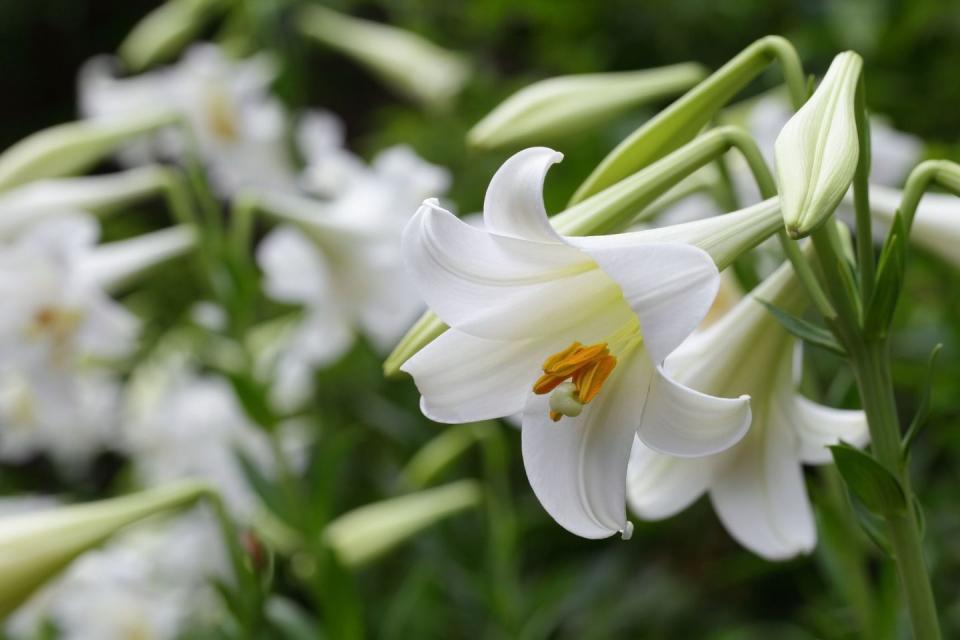Your Guide To Growing and Caring for an Easter Lily
The Easter lily first came to the United States in the early 1900s, by way of Japan's Ryukyu Islands. Today, these beautiful Easter flowers are typically displayed in churches and homes as an Easter tradition to symbolize purity, renewal, and rebirth. Also known by their scientific name, Lilium longiflorum, these lilies are traditionally white or white with faint pink streaks.
Easter lilies are not an easy crop to raise and must be cultivated in fields for two to four years before they’re big enough to harvest. Then, they're shipped to nurseries where temperature and light conditions must be carefully controlled for months so that the plants will be "tricked" into blooming in time for Easter—a date which changes every year, usually occurring between March 22 and April 25.
Learning how to grow Easter lilies is worth it, though, for their symbolic beauty alone! Here's everything you need to know about Easter lilies and how to care for them.

What is the significance of the Easter lily?
White lilies are mentioned many times throughout the Bible as symbols of purity, rebirth, and hope. They are most closely associated with Jesus' resurrection so it should come as no surprise that we like to display them around the Easter holiday. Even the lily's life cycle brings to mind Jesus's death and resurrection, while its trumpet-shaped blooms are thought to represent the horns that announced his return.
How do I care for an Easter lily?
Water and Light
Choose a plant with no yellow leaves and unopened buds in several different stages so you'll have a longer bloom time. Place your plant in a bright indirect light away from chilly drafts or heating vents. Make sure to remove the plastic sleeve and foil pot cover so water can drain out of the bottom. (No plant likes soggy roots!) Water when the soil surface feels dry, and dump out excess water from the saucer. It's also a good idea to remove the yellowish pistils in the center of the flower so pollen doesn't drop and stain the flower petals or tablecloths and furniture.
Soil and Water
Easter lilies thrive in well-draining soil rich in organic matter. During their growth period, it's important to water them regularly. Watering early in the day allows the leaves to dry out before night, reducing the risk of mildew.
Fertilizer
To help your lily reach its full potential, finding the right fertilizer is key. In early spring, as Easter lily buds start to appear, use a fertilizer high in phosphorus. This nutrient is crucial for the development of vibrant blooms.
How do I get an Easter lily to bloom?
It doesn't take much! Growers use precise techniques to get the plants to bloom in time for Easter, so the hard part is done by the time you buy your Easter lily. All you need to do is place the plant in a cool room, around 60 to 65 degrees, so that the spring flowers will last longer. Typically, they'll bloom for about a week to 10 days indoors.
Plant your Easter lily outdoors after it blooms.
After each flower wilts, snap it off at the base. When there are no more flowers, remove the stalk so it won't put energy into developing seed, and plant your lily outside after all danger of frost has passed. Find a spot where it will receive full sun, which is six or more hours of direct sunlight per day. In hot climates, give it some afternoon shade. Make sure it's not a soggy spot, because lilies don't like to stay wet.
Plant the lily at the same depth it was in the pot. Mulch with straw, pine needles, or wood chips to protect the plant over the winter, but remove the mulch in the spring as new green shoots appear. Easter lilies do best in USDA hardiness zones 4 to 8, but it never hurts to try wherever you live! With good luck, they should bloom the following year in early to mid-summer. If they're really happy, they'll continue to multiply.
Are Easter lilies poisonous to pets?
Unfortunately, Easter lilies are not safe for pets, especially cats. In fact, all lilies and all parts of the Easter lily plant—including the pollen—are deadly to cats. Even a few lily leaves or small amount of pollen ingested while grooming (or even when drinking water from a vase!) may cause severe kidney failure. Keep this plant away from your fur babies or skip it altogether if you have a nibbler! And call your vet immediately if you suspect your pet has licked or ingested any part of the Easter lily plant.
You Might Also Like

